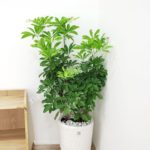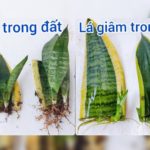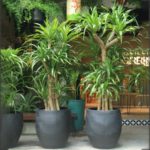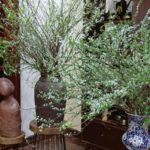The Rubber Tree, or Ficus elastica, commonly known as the Red-Leaved Rubber Tree, is a popular houseplant with cultural and symbolic significance. Many believe that this plant brings good luck and is often kept in homes and offices. Let’s explore its characteristics, meanings, and care instructions.
1 Introducing the Red-Leaved Rubber Tree
 Introducing the Red-Leaved Rubber Tree
Introducing the Red-Leaved Rubber Tree
Native to Northeast India and extending down to Southern Indonesia, the Red-Leaved Rubber Tree is an impressive plant. In its natural habitat, it can grow to towering heights of 20-40 meters. However, when kept as a houseplant, it remains a modest size of 0.2-1 meter.
Its root system is extensive, with many auxiliary roots that enable it to thrive even in challenging climatic conditions. The leaves of the Red-Leaved Rubber Tree are thick, oval-shaped, and glossy, with a unique reddish hue when young, maturing to a bright green color.
The flowers of this tree are a captivating feature. They bloom in clusters, starting as a vibrant orange and gradually turning black as they age. These flowers typically appear between May and June, followed by oval-shaped fruits containing edible yellow seeds.
 A Closer Look at the Flowers
A Closer Look at the Flowers
2 The Symbolic Significance of the Red-Leaved Rubber Tree
 The Symbolic Significance of the Tree
The Symbolic Significance of the Tree
In Vietnamese culture, the Red-Leaved Rubber Tree holds a wealth of symbolic value. It represents good fortune and happiness, and it is believed that having this tree in your home fosters harmony and peace. Additionally, the tree symbolizes resilience, endurance, and a strong will, making it a popular gift for special occasions such as housewarmings, birthdays, and business openings.
3 The Practical Benefits of the Red-Leaved Rubber Tree
 The Practical Benefits of the Tree
The Practical Benefits of the Tree
Aside from its symbolic significance, the Red-Leaved Rubber Tree is valued for its aesthetic appeal and air-purifying properties. It is often used as a decorative plant on desks, reception areas, and balconies, adding a touch of freshness to any space. Furthermore, it effectively filters the air, removing dust and harmful substances, including those found in cigarette smoke.
4 Feng Shui and the Red-Leaved Rubber Tree
 Feng Shui and the Red-Leaved Rubber Tree
Feng Shui and the Red-Leaved Rubber Tree
According to Feng Shui principles, the Red-Leaved Rubber Tree is particularly well-suited for individuals with the Fire element in their birth chart. This includes those born in the years of the Giáp Tuất, Đinh Dậu, Bính Dần, Ất Hợi, Giáp Thìn, and Đinh Mão, among others. Additionally, individuals with the Earth element, such as those born in the years of the Mậu Dần, Tân Sửu, Canh Ngọ, Kỷ Mão, Mậu Thân, and Tân Mùi, are also considered compatible with this plant.
For those with the aforementioned elements and birth years, incorporating the Red-Leaved Rubber Tree into their living or working space is believed to bring good luck and facilitate smoother endeavors.
5 Planting and Caring for the Red-Leaved Rubber Tree
Planting Techniques
 Planting Techniques
Planting Techniques
There are several methods to propagate the Red-Leaved Rubber Tree, including seed germination, cutting, and air layering. However, the latter two techniques are often preferred as they are less time-consuming and better preserve the characteristics of the parent plant.
Cutting
To propagate through cutting, select a healthy branch from the middle of the tree. Remove the leaves, leaving about 3 buds, and apply lime to the cut areas. Then, plant the cutting in soil, maintaining a temperature of 18-25 degrees Celsius for 2-3 weeks until roots develop.
Air Layering
For air layering, choose a robust branch and scrape the bark to expose the inner layer. Apply a rooting hormone and cover the area with a ball of soil made from coconut husk or charred rice hulls. Water daily to keep it moist. Once the branch has developed a substantial root system, cut it from the parent plant and transfer it to a pot, watering regularly to encourage growth.
Care Instructions
 Care Instructions
Care Instructions
Soil
The Red-Leaved Rubber Tree thrives in well-drained, nutrient-rich, and airy soil. Mixing the soil with ash or coconut husk helps improve drainage and prevents root rot and fungal infections.
Watering
Water the plant about once a week, adjusting the frequency according to the season. During the summer, increase watering to prevent dehydration, while reducing it during the rainy season.
Light
Provide the plant with moderate light, avoiding direct sunlight, which can scorch the leaves. Insufficient light will hinder its growth, so aim for a balance to ensure a lush and rounded canopy.
Temperature
Maintain a temperature range of 18-25 degrees Celsius. Extremes in temperature, either too hot or too cold, can be detrimental to the plant’s health.
Fertilizer
Once a month, feed the plant with a diluted solution of NPK fertilizer to promote healthy growth.
Pruning
Prune the top and side branches to control the height and encourage branching, giving the plant a fuller appearance.
Leaf Cleaning
Use a soft cloth or sponge dampened with warm water to gently wipe the leaves, removing any dust or grime. This improves the plant’s photosynthetic efficiency and enhances its aesthetic appeal.
Pests and Diseases
The Red-Leaved Rubber Tree is susceptible to charcoal rot, often caused by high temperatures and excessive sunlight. To prevent this, prune dry branches and leaves, and choose healthy branches for propagation.
6 Where to Buy and Price Range
 Where to Buy and Price Range
Where to Buy and Price Range
We hope that this comprehensive guide has provided you with valuable insights into the Red-Leaved Rubber Tree. Now you can appreciate its beauty and significance even more!
Differentiating Between Forest and Garden Frost Flowers for Proper Care
Even though both snowflakes, trees in the forest and plants in the garden require different care in order to bloom beautifully.






































